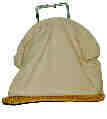Rock & Stone
Rock is an aggregation of solid matter composed of one or more of the minerals forming the earth's crust. The scientific study of rocks is called petrology. Rocks are commonly divided, according to their origin, into three major classes - igneous, sedimentary, and metamorphic.
Not all rock-like materials are created by nature. Almost all civilizations have depended to some extent on artificial building materials, the most common of which are concrete, brick, and asphalt.
Natural Rock
Igneous Rocks
Igneous rock originates from the cooling and solidification of molten matter from the earth's interior. If the rock is formed on the earth's surface ( i.e., from the solidification of lava ), it is called extrusive rock; igneous rock that has cooled and solidified slowly beneath the earth's surface is intrusive rock. Among the forms commonly taken by intrusive rocks are batholiths, which are enormous, irregular masses cutting or displacing older rocks; stocks, irregular and
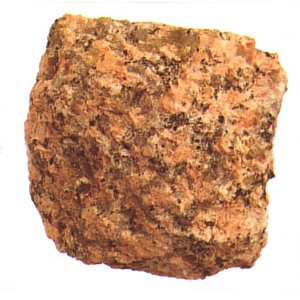
smaller than batholiths; necks, or plugs, columnar in form and probably the result of the hardening of magma in the necks of extinct volcanoes; dikes, more or less vertical, filling fissures in previously existing rock; sills, more or less horizontal, forced between layers of previously existing rock; and laccoliths, modified domelike sills that arch under the overlying rock.
Igneous rocks are commonly divided into classes by texture. Some rocks are markedly granular ( e.g., granite, syenite, diorite, gabbro, peridotite, and pyroxenite ), while others ( e.g., basalt, trachite, dacite, and andesite ) are composed of grains visible only under a microscope. Both fine-grained and coarse-grained igneous rocks frequently contain grains called phenocrysts that are larger than the surrounding grains; such rocks are said to be porphyritic in texture. Rocks with grains of uniform size are called equigranular.
Igneous rocks are commonly light in color if their constituent minerals are predominantly alkali feldspars and dark in color if the feldspars are calcic or if magnesia and iron minerals are abundant. The glassy igneous rocks include obsidian, pitchstone, and pumice, which contain few or no phenocrysts, and vitrophyre, or glass porphyry, which does contain phenocrysts. Rocks such as tuff and volcanic breccia, which are formed from fragmental volcanic material, are sometimes grouped as pyroclastic rocks.
Sedimentary Rocks
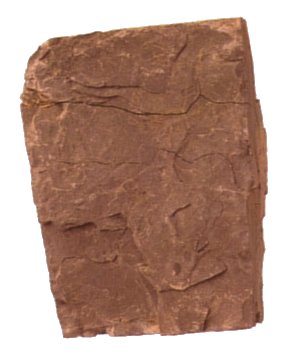
Sedimentary rocks originate from the consolidation of sediments derived in part from living organisms but chiefly from older rocks of all classes ( ultimately the mineral elements are derived from igneous rocks alone ). The sediments of inorganic origin are chiefly removed from older rocks by erosion and transported to the place of deposition; chemical precipitation from solution is a secondary cause of deposition of inorganic matter. Sedimentary rocks are commonly distinguished, according to their place of deposition, by a great variety of terms, such as continental, marine (i.e., oceanic), littoral ( i.e., coastal ), estuarine ( i.e., in an estuary ), lacustrine ( i.e., lakes ), and fluviatile, or fluvial ( i.e., in a stream ).
The characteristic feature of sedimentary rocks is their stratification; they are frequently called stratified rocks. Sedimentary rocks made up of angular particles derived from other rocks are said to have a clastic texture, in contrast to pyroclastic sediments, which are particles of volcanic origin. Among the important varieties of sedimentary rock, distinguished both by texture and by chemical composition, are conglomerate, sandstone, tillite, sedimentary breccia, shale, marl, chalk, limestone, coal, lignite, gypsum, and rock salt. Characteristic occurrences in sedimentary rocks are fossils, footprints, raindrop impressions, concretions, oolites, ripple marks, rill marks, and crossbedding. Some of these features are useful in determining the antiquity of sedimentary formations and in interpreting geologic history.
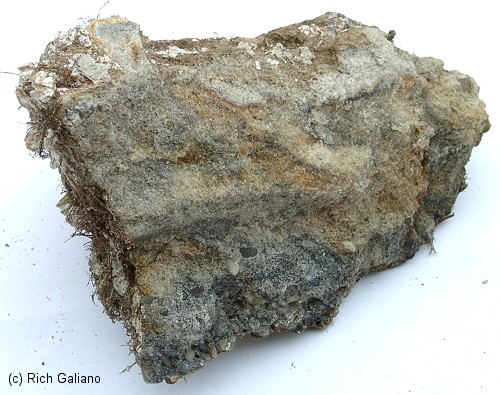
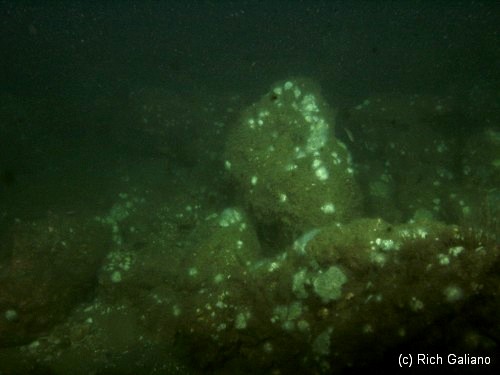
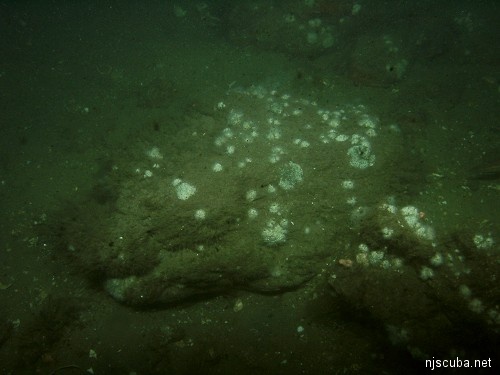
Metamorphic Rocks
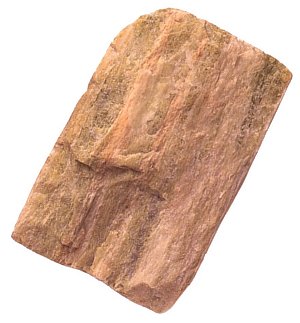
Metamorphic rocks originate from the alteration of the texture and mineral constituents of igneous, sedimentary, and older metamorphic rocks under extreme heat and pressure deep within the earth. Some ( e.g., marble and quartzite ) are massive in structure; others, and particularly those which have been subject to the more extreme forms of metamorphism, are characterized by foliation ( i.e., the arrangement of their minerals in roughly parallel planes, giving them a banded appearance ). A distinguishing characteristic of many metamorphic rocks is their slaty cleavage. Among the common metamorphic rocks are schist ( e.g., mica schist and hornblende schist ), gneiss, quartzite, slate, and marble.
Un-natural Rock Formations
Marble, Granite, and Limestone are the three stones most likely to be found on an old shipwreck. All are used in the building trades, and marble, the most precious of the three, also has artistic value and is used in statuary, gravestones, and other works. All occur in a wide range of colors and patterns, not just the samples shown below. Huge amounts of granite have been dug out in building projects in New York City, and much of this material has been used in shoreline structures, or simply dumped offshore.
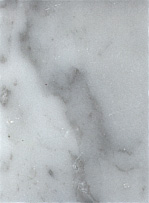 Marble | 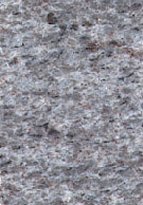 Granite | 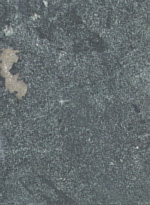 Limestone |
Granite

Granite is a coarse-grained igneous rock of even texture and light color, composed chiefly of quartz and feldspars. It usually contains small quantities of mica or hornblende, and minor accessory minerals may be present. Depending on the feldspar present, granite may be pink, dark gray, or light gray. It is commonly believed to have solidified from molten rock ( called magma ) under pressure. However, some granites show no contact with surrounding wall rock, but instead gradually grade into metamorphic rock. Others show relic features found in sediments. This evidence suggests that some granites are not igneous in origin, but metamorphic.
Some granites are the oldest known rocks on earth; others were formed during younger geologic periods. Crystallized at depth, granite masses are exposed at the earth's surface by crustal movement or by the erosion of overlying rocks. Very coarse-grained granite, called pegmatite, may contain minerals and gemstones of economic value. Such pegmatites are found in the Black Hills of South Dakota. Granite has been used by man since ancient times as a building material.
Much of the granite used in the construction of local sea walls and beach and inlet jetties was a byproduct of the construction of the New York City subway system, and the huge blocks were transported by sea. Very large stones, as found on the Granite Wreck or the Cornelia Soule, are most likely cargo, while fields of smaller stones were probably just ballast. Other types of stone which might occur as cargo include slate, sandstone, and coal. A great deal of stone is also deposited by the Artificial Reef Program, especially on the Sandy Hook Reef.
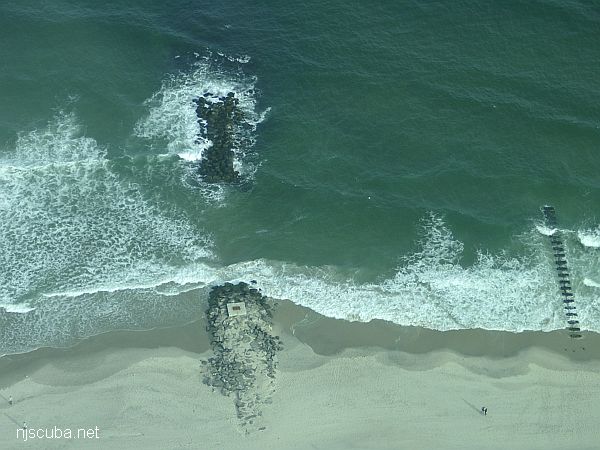
There are hundreds of stone jetties ( properly called "groins" ) along the New Jersey and Long Island coasts.
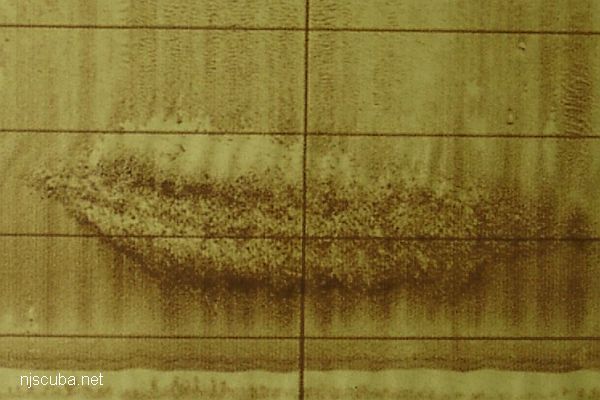
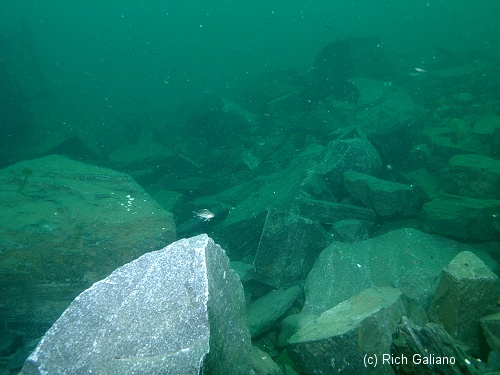
Granite has a density of 162 lb / cu ft, or 12.3 cu ft/ton. 1000 tons of granite is equal to approximately 450 cubic yards, or a solid cube 23 feet on a side.
Marble

Marble is a metamorphic rock composed wholly or in large part of calcite or dolomite crystals, the crystalline texture being the result of metamorphism of limestone by heat and pressure. The term marble is loosely applied to any limestone or dolomite that takes a good polish and is otherwise suitable as a building stone or ornamental stone. Marbles range in color from snow-white to gray and black, many varieties being some shade of red, yellow, pink, green, or buff; the colors, which are caused by the presence of impurities, are frequently arranged in bands or patches and add to the beauty of the stone when it is cut and polished.
Marble is used as a material in statuary and monuments, as a facing stone in buildings and residences, and for pillars, colonnades, paneling, wainscoting, and floor tiles. Like all limestones, it is corroded by water and acid fumes and is thus ultimately an uneconomical material for use in exposed places and in large cities. The presence of certain impurities decreases its durability. Marble was extensively used by the ancient Greeks; the Parthenon and other famous buildings were constructed of white Pentelic marble from Mt. Pentelicus in Attica, and the finest statues, e.g., the Venus de Medici, from the remarkably lustrous Parian marble from Paros in the Cyclades. These same quarries were later used by the Romans. Among the famous marbles of Italy are the Carrara and Siena marbles of Tuscany, which were used by the Romans and the Italian sculptors of the Renaissance. Marbles are quarried in all parts of the world. The finest marbles in the United States come from Vermont, which produces large quantities. Other states that are important as marble producers are Massachusetts, Maryland, Tennessee, Alabama, Georgia, Missouri, California, Colorado, and Arizona.
Limestone

Limestone is a sedimentary rock wholly or in large part composed of calcium carbonate. It is ordinarily white but may be colored by impurities, iron oxide making it brown, yellow, or red and carbon making it blue, black, or gray. The texture varies from coarse to fine. Most limestones are formed by the deposition and consolidation of the skeletons of marine invertebrates; a few originate in chemical precipitation from solution. Limestone deposits are frequently of great thickness.
The action of organic acids on underground deposits causes such formations as the Luray Caverns, the Carlsbad Caverns, and Mammoth Cave. Limestone is used as a flux in the extraction of iron, as an ingredient in Portland cement, as a source of lime, as a building stone, and for ornamentation. Among the important varieties of limestone are marl, chalk, oolite, travertine, dolomite, and marble.
Limestone has a density of 125 lb / cu ft, or 16 cu ft/ton. 1000 tons of limestone is equal to approximately 600 cubic yards, or a solid cube 25 feet on a side.
Coal
Coal is a fuel substance of plant origin, largely or almost entirely composed of carbon with varying amounts of mineral matter. Because of its combustible nature, coal is not always thought of as a rock, but it is.
Types
There is a complete series of carbonaceous fuels, which differ from each other in the relative amounts of moisture, volatile matter, and fixed carbon they contain. Of the carbonaceous fuels, those containing the largest amounts of fixed carbon and the smallest amounts of moisture and volatile matter are the most useful to humans. The lowest in carbon content, peat, is followed in ascending order by lignite and the various forms of coal - sub-bituminous coal or black lignite ( a slightly higher grade than lignite ), bituminous coal, semi-bituminous ( high-grade bituminous coal ), semi-anthracite ( low-grade anthracite ), and anthracite.
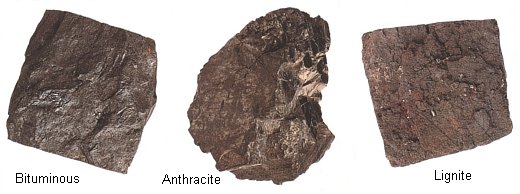
Lignite and sub-bituminous coal, because of the high percentage of moisture they contain, tend to crumble on exposure to the air. Bituminous coal, being more consolidated, does not crumble easily; it is a deep black in color, burns readily, and is used extensively as fuel in industries and on railroads, and in making coke. Anthracite, which is nearly pure carbon, is very hard, black, and lustrous and is extensively used as a domestic fuel. Cannel coal, a dull, homogeneous variety of bituminous coal, is composed of pollen grains, spores, and other particles of plant origin. It ignites and burns easily, with a candle-like flame, but its fuel value is low.
Formation
The vegetable origin of coal is supported by the presence in coal of carbonized fibers, stems, leaves, and seeds of plants, which can be detected with the naked eye in the softer varieties and with the microscope in harder coal. Sometimes carbonized tree stumps have been found standing in layers of coal. The general interpretation of these facts is that coal originated in swamps similar to present-day peat bogs and in lagoons, probably partly from plants growing in the area and partly from plant material carried in by water and wind. From the thickness of coal seams, it is assumed that the coal swamps were located near sea level and were subject to repeated submergence, so that a great quantity of vegetable matter accumulated over a long period of time.
The initial processes of disintegration and decomposition of the organic matter were brought about by the action of bacteria and other microorganisms. Peat, the first product formed, is altered to form lignite and coal through metamorphism. The pressure of the accumulated layers of overlying sediments and rock upon the submerged plant matter forced out much of the water and caused some of the volatile substances to escape and the nonvolatile carbon material to form a more compact mass. The greater the stress exerted in the process of metamorphism, the higher was the grade of coal produced. Cannel coal was probably formed in ponds, rather than in lagoons or swamps, as it occurs in lenticular masses and is frequently found to contain fossil fish. Coal was formed chiefly in the Carboniferous period of geologic time, but valuable deposits date also from the Permian, Triassic, Jurassic, Cretaceous, and Tertiary periods.
Natural Occurrence
Coal is found in beds or seams interstratified with shales, clays, sandstones, or (rarely) limestones. It is usually underlain by an underclay (a layer of clay containing roots of plants). The coal is removed by strip (surface) mining or underground mining methods.
The chief coal fields of the United States are the Appalachian ( from N Pennsylvania into Alabama ), the Eastern Interior ( Illinois, Kentucky, and Indiana ), the Northern Interior (Michigan), the Western Interior (Iowa, Kansas, Missouri, Oklahoma, and Arkansas ), the Rocky Mountain ( Colorado, Wyoming, Utah, New Mexico, Montana, and North Dakota ), the Pacific ( Washington ), and the Gulf Coast ( Texas, Arkansas, and Louisiana ). In Europe, the chief coal-producing countries are Russia, Ukraine, Germany, Great Britain, Poland, France, and Belgium. There are valuable coal fields in China, Siberia, India, South Africa, and Australia, but few in South America.
Coal was the primary fuel for steamships until around World War I, when oil became predominant. Coal for these vessels was a major bulk cargo for schooner barges, so many of which sank in this service that the bottom of Long Island Sound has been said to be paved with coal. Later, a specialized type of vessel known as a collier was developed but has since fallen out of use, and most coal today is again transported on barges.
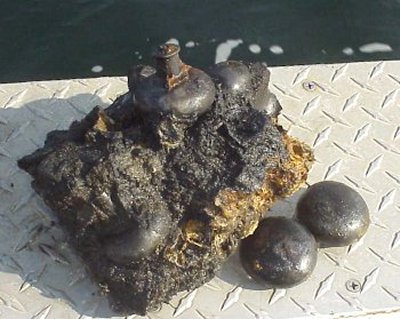
Coal is usually dark-colored if not black. Long immersion in the sea causes it to become concreted into big masses which often contain other artifacts. Other materials, such as packing straw, may also congeal into black coal-like masses. In either case, the material is an ugly mess to handle and will stain clothes, hands, and the boat almost indelibly.
Being relatively light and buoyant, chunks of coal are easily transported downriver from inland sources and then deposited on the beaches. Such naturally-occurring "beach-coal" was once so common that settlers would go out and collect it for fuel.
Concrete
Concrete is a structural masonry material made by mixing broken stone or gravel with sand, cement, and water and allowing the mixture to harden into a solid mass. The cement is the chemically active element or matrix; the sand and stone are the inert elements or aggregate. Concrete is adaptable to widely varied structural needs, is available practically anywhere, is fire resistant, and can be used by semiskilled workers.

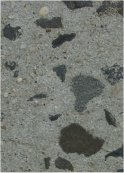
Concrete - various consistencies
The use of artificial masonry similar to modern concrete dates from a remote period but did not become a standard technique of construction until the Romans adopted it ( after the 2d cent. B.C. ) for roads, immense buildings, and engineering works. The concrete of the Romans, formed by combining pozzuolana ( volcanic earth ) with lime, broken stones, bricks, and tuff, was easily produced and had great durability ( the Pantheon of Rome and the Baths of Caracalla were built with it ). Enormous spaces could be roofed without lateral thrusts by vaults cast in the rigid homogeneous material.
Scientifically proportioned concrete formed with cement is an invention of modern times; the name did not appear until c.1830. Modern portland cement has revolutionized the production and potentialities of concrete and has superseded the natural cement, to which it is vastly superior. The component materials of concrete are mixed in varying proportions, according to the strength required and the function to be fulfilled; the proportions were first worked out by Duff Abrams in 1918. The ideal mixture is that which solidifies with the minimum of voids, the mortar, and small particles of aggregate filling all interstices. A typical proportioning is 1:2:5, i.e., one part of cement, two parts of sand, and five parts of broken stone or gravel, with the proper amount of water for a pouring consistency. A simple test called a "lump test" is used to confirm the proportions and consistency of the mixture, and it is then poured into wood or steel molds, called forms. Concrete usually takes about five days to cure or reach acceptable hardness, but a technique called steam saturation can shorten that curing time to less than 18 hours. A wide variety of additives allow the concrete to harden faster or slower, resist scaling, or adopt the final shape more easily.
Concrete used without strengthening is termed mass, or plain, concrete and has the structural properties of stone - great strength under compressive forces and almost none under tensile ones. F. Joseph Monier, a French inventor, found that the tensile weakness could be overcome if steel rods were embedded in a concrete member. The new composite material was called reinforced concrete, or ferroconcrete. It was patented in 1857, and a private house in Port Chester, N.Y., first demonstrated (1857) its use in the United States. It is now rivaled in popularity as a structural material only by steel. Concrete reinforced with polypropylene fibers instead of steel yields equivalent strength with a fraction of the thickness.
Reinforced concrete was improved by the development of prestressed concrete - that is, concrete containing cables that are placed under tension opposite to the expected compression load before or after the concrete hardens. Another improvement, thin-shell construction, takes advantage of the inherent structural strength of certain geometric shapes, such as hemispherical and elliptical domes; in thin-shell construction, great distances are spanned with very little material. The perfecting of reinforced concrete has profoundly influenced structural building techniques and architectural forms.
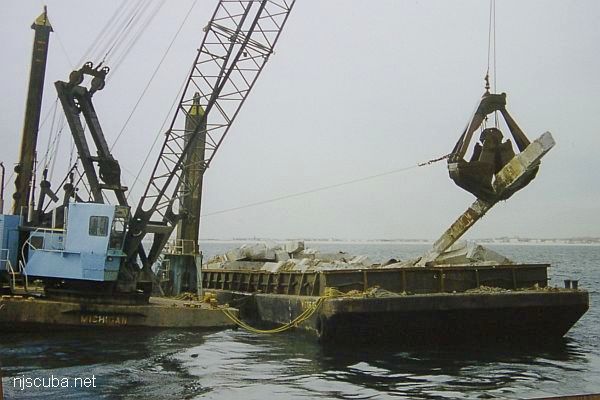

Modern "Portland" cement is a mixture of lime, clay, and other materials. The lime is generally derived from crushed limestone, dug out of quarries like Dutch Springs. Although the terms cement and concrete are often used interchangeably, this is not technically correct, as cement is really just the powdery dry binding constituent in concrete and not the whole mix. When water is added, a chemical reaction occurs which binds the constituents together into a single strong, hard mass. The reaction is not merely drying as one might think, and in fact, it generates considerable heat and continues at a reduced rate throughout the life of the material. The resulting effect is that concrete can actually get stronger ( or at least harder ) over time, discounting cracks from wear, weather, and shrinkage.
Concrete finds its way into our artificial reefs as the product of construction demolitions. The Sandy Hook artificial reef is little more than a convenient dumping ground for concrete and rock rubble from New York City and neighboring areas, with the Sea Girt and Shark River reefs receiving a fair share as well. Southern reefs serve much the same purpose for Philadelphia. All of this clean solid debris makes splendid habitat for fish, lobsters, and other marine life.
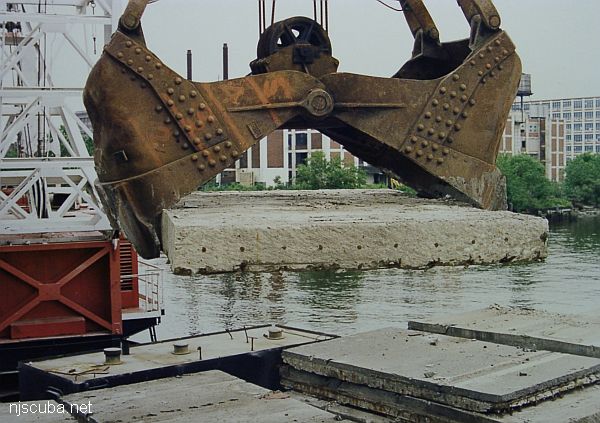
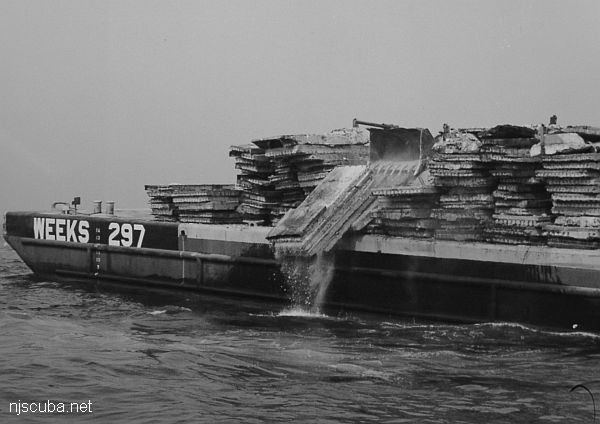
Concrete construction debris can occur as slabs from torn-up roadbeds and bridges, large blocks, or pipes. This heavy material slowly but inexorably sinks into the bottom sediments and is generally dumped in heaps so that some useful amount will remain after a few years. Often, new material is dumped on top of old for this same reason. Salt attacks concrete, while water makes it stronger, and in the ocean, the two effects seem to cancel each other.
Brick
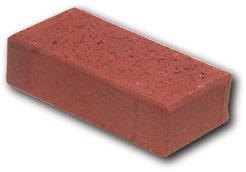
Brick is a ceramic structural material that, in modern times, is made by pressing clay into blocks and firing them to the requisite hardness in a kiln. Bricks in their most primitive form were not fired but were hardened by being dried in the sun. Sun-dried bricks were utilized for many centuries and are used even today in regions with the proper climate. Examples from approximately 5,000 years ago have been discovered in the Tigris-Euphrates basin, and the ancient races occupying this region may have been the first users of brick. In Babylonia, there was a lack of both timber and stone, and the thick clay deposited by the overflowing rivers was the only material adaptable to building.
The Persians and the Assyrians used sun-dried blocks of clay for walls of great thickness, facing them with a protective coating of fired bricks. The Egyptians and the Greeks used bricks only to a limited extent, as they had access to plentiful supplies of stone and marble. The Romans manufactured fired bricks in enormous quantities and gave them an important role as a basic structural material in buildings throughout the Roman Empire.
Bricks played an important part in early Christian architecture until the decline of the empire. Whereas the Romans had usually concealed their brickwork beneath a decorative facing of stone or marble, the Byzantines devised a technique for exposing the bricks and giving them a full decorative expression. This technique influenced the Romanesque style and brought especially good results in Lombardy and in Germany, where bricks came to be arranged in immensely varied patterns.
Since the Middle Ages, brickwork has been in constant use everywhere, adapting itself to every sort of construction and to every change of architectural style. At the beginning of the 19th cent. mechanical brick-making processes began to be patented and by the latter half of the century had almost entirely replaced the ancient hand-fashioning methods.
Contemporary American building bricks are rectangular blocks with the standard dimensions of about 2 1/4 by 3 3/4 by 8 in. Good bricks are resistant to atmospheric action and high temperatures and are more durable than stone. Where heat resistance is especially important, fire bricks are used; these are made of special refractory clays called fire clays and are fired at very high temperatures.
Contrary to appearances, bricks do degrade over time in the water. Bricks are often found on old steamship wrecks, especially wooden-hulled ones, where they were used as insulation around the boilers, fire-boxes, and galley, as well as for ballast. They may also occur as cargo. Antique bricks are common artifacts in some parts of this state since a brickmaking industry once thrived from Raritan Bay down to the shore. Much of New York City must have been built with New Jersey bricks. Ironically, the town of Brick is not named for the familiar red building block.
Cinderblock is a material that is outwardly similar to brick but is actually made from a mixture of coal cinders and concrete. Cinderblock degrades readily in saltwater.
Asphalt
Asphalt is a brownish-black substance used commonly in road making, roofing, and waterproofing. Chemically, it is a natural mixture of hydrocarbons. It varies in consistency from a solid to a semi-solid, has great tenacity, melts when heated, and when ignited will burn with a smoky flame leaving very little or no ash. It is found in nature in deposits called asphalt lakes. Natural asphalt was probably formed by the evaporation of petroleum.
Asphalt is obtained as a residue in the distillation or refining of petroleum. This is its important commercial source. It occurs also in asphalt rock, a natural mixture of asphalt with sand and limestone, which when crushed is used as road-building material. Asphalt is also used in the manufacture of paints and varnishes, giving an intensely black color.
Modern tarred roads were the result of the work of two Scottish engineers, Thomas Telford and John Loudon McAdam. Telford designed the system of raising the foundation of the road in the center to act as a drain for water. Thomas Telford (born 1757) improved the method of building roads with broken stones by analyzing stone thickness, road traffic, road alignment, and gradient slopes. Eventually, his design became the norm for all roads everywhere. John Loudon McAdam (born 1756) designed roads using broken stones laid in symmetrical, tight patterns and covered with small stones to create a hard surface. McAdam's design, called "macadam roads, " provided the greatest advancement in road construction.
Today, 96% of all paved roads and streets in the U.S. - almost two million miles - are surfaced with asphalt. Almost all paving asphalt used today is obtained by processing crude oils. After everything of value is removed, the leftovers are made into asphalt cement for pavement. Man-made asphalt consists of compounds of hydrogen and carbon with minor proportions of nitrogen, sulfur, and oxygen. Natural forming asphalt, or brea, also contains mineral deposits.
The first road use of asphalt occurred in 1824 when asphalt blocks were placed on the Champs-Elysees in Paris. Modern road asphalt was the work of Belgian immigrant Edward de Smedt at Columbia University in New York City. By 1872, De Smedt had engineered a modern, "well-graded, " maximum-density asphalt. The first uses of this road asphalt were in Battery Park and on Fifth Avenue in New York City in 1872 and on Pennsylvania Avenue, Washington D.C., in 1877.
Asphalt is one common construction material that you will not find in an artificial reef. Asphalt is eminently recyclable - just reheat and lay it back down, so dumping it in the ocean would not only be a waste of valuable petrochemicals but a major source of pollution!
compiled from various sources

